CONTINUED FROM PART 1.
Part 1 of A Complete Beginner's Guide To Hive had Harry learning how to join Hive, manage his keys, learn to post with resource credits, etc. We left off in the middle of him learning about Voting Etiquette, so that's where we'll pick up.
"Let's see how well you know the etiquette, Harry...
6. ENGAGEMENT (REPLIES, UPVOTES, ETC.)
...What's the best way to reply, upvote, and reblog?
“OK, I think I got this.”
“Impress me.”
“I’ll read the comment. If I feel it deserves a reply, I’ll reply. I’ll upvote it too, but only with 10%, because I’m new and I don’t have much Resource Credits / Hive Power, and I don’t want to burn all my Voting Mana. Smart right?”
“Very. You’re almost right.”
“What do you mean ‘almost right?'”
“Well, since you’re new your votes aren’t worth much. And since your votes aren’t worth much, when you vote, you’re only earning a tiny percentage of a Hive token. Like $0.0001 of a cent. And if you remember, there is a ‘dust threshold’, where no one will earn anything unless a piece of content crosses the two-cent mark.”
“Aaaaahhh, I forgot about that. So even my 100% vote won’t push another’s comment past the dust threshold. So I’d burn my entire vote, lose vote mana, and earn myself and the commenter I’m replying to… nothing?”
"'Burning' votes is one of the most wasteful things on Hive."
“Now I get why people might be a bit touchy about it. It’s kind of like watching someone throw away a Michelin-star meal. It’s their choice, but dang, it hurts to watch.”
“That’s as good a comparison as any.”
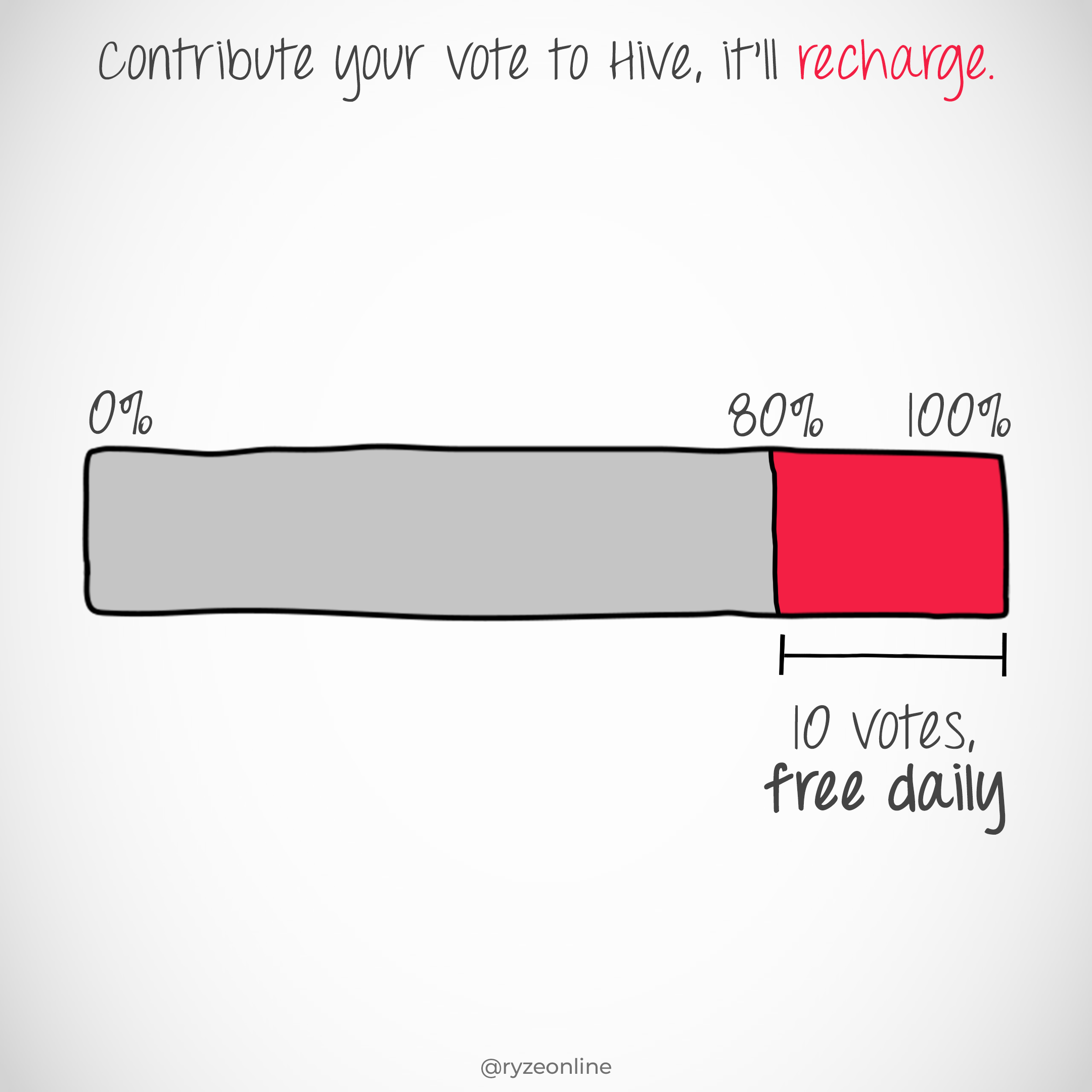
“OK, so I’ll do what I said earlier, but since I’m new, I will not upvote my commenters.”
EDIT: Following paragraph corrected due to insight from @meesterboom :)
“Actually, the best advice I've seen for a newbie is to 'vote freely.' Yes they may not cross the dust threshold, but it's good karma. It's good will, and your votes recharge anyway. So just show love to people, vote up any comment you like, the thought counts. Just know that upvoting other people’s original content is technically a bit more impactful. Can you tell me why?”
I could see the gears turning Harry’s brain. “Hmmm. Well, because since it’s only me voting on my thread’s comments, my votes remain ‘dust votes’ there. But if I vote on original content, it’s likely many others will click upvote when they see the content too, so it’s very likely the dust threshold will be met, and my ‘dust votes’ will actually become worth something and begin paying out, just like everybody else who voted on the original content. Did I get it right?”
I clapped! “You totally did!
And one more thing about voting etiquette is...
You can upvote yourself. Which is basically like 'paying' yourself, and it's mostly frowned upon. I know what you're thinking, 'should I upvote my own stuff?' And the answer is, try to avoid it. You have a limited number of votes and resource credits, and it's usually seen better by others if you use your resources to engage and show love to others, not 'self-promote.' Instead, try trusting that other people will upvote your content if they like it. That said, occasionally, if you think something really needs to 'float to the top' or be recognized, that might be a time to self-upvote.”
“Got it, thanks chief! I just realized though, I have no clue about re-blogging.”
"Reblogging is easy."
“Thank god.”
“It’s the same as on other platforms. Similar to retweeting on Twitter or sharing on Facebook. Once you re-blog a post it shows in your (and your followers’) feeds as if you had posted it yourself. Also PeakD allows you to remove reblogs that you've chosen at a later date if you'd like. That’s it.”
“Makes sense. But since everything ‘earns’ HIVE tokens, which can be converted into real money… do I get paid for re-blogging?”
“I don’t believe so. It’s just a fun, kind thing to do. Reblogging costs Resource Credits and returns nothing, at least not directly.”
“Sweet.”
“Payouts on Hive do happen though.”
“How?”
7. EARNINGS
"In HIVE Tokens, Hive Power, & Hive-Backed Dollars (The 3 Currencies)"
“This drove me nuts when I first joined. I thought…
Why the f--k would you name 3 currencies all nearly identically?”
“I know, right?”
“Imagine if I made three U.S. Currencies: ‘US Tokens,’ ‘US Power,’ and ‘US-Backed Dollars’… you think any United States citizen would have any clue what was going on with their money? They’d store some in one currency, some in another. Some could be used to spend, others would be locked up. And they all have nearly the same name. It’s pure chaos.”
“Yeah, this doesn’t seem ideal.”
“It’s not. But Hive still rocks. And their 3 currencies are still easy to understand. If you want to earn on Hive, you’ll have to figure it out.”
“You’re gonna help me, right?”
“Well, no one held my hand through all this. Maybe I’m done teaching for now…”
“Bro! No way, we’re at the money part. C’mon ese!”
“Hehe, I gotchu, was just playin’.

First I’ll explain the 3 currencies on Hive.io:
HIVE Tokens (HIVE) is the primary currency on the Hive blockchain. It’s basically the same as bitcoin. (It’s the main token on the Hive.io blockchain.) You can spend, receive, transfer, and trade them. (Also sometimes called ‘Hive Tokens,’ or ‘Hive Coins.’)”
Hive Power (HP, or VESTS) is HIVE tokens that you’ve ‘locked up’ for use on Hive.io’s social platform. This is also called ‘staking’ your HIVE tokens.) Hive Power can also be earned by performing social actions on Hive.io, thus gaining rewards.”
“And I do those social actions through a dApp like Hive.Blog or PeakD, right?”
“Exactly. The thing is, Hive Power isn’t a ‘real’ cryptocurrency.”
“It’s not?”
“Well, it’s not a ‘liquid’ currency.”
“What’s ‘liquid’ mean?”
“Liquid currency means easily tradeable for other stuff. Picture how easily water flows in your mind. A currency that flows like that is ‘liquid.’ Money on your debit card is very liquid, just swipe and spend, basically anywhere! Money invested in stocks though, is much more solid, less flowing, less liquid. Same goes for HIVE tokens (liquid) & Hive Power (not liquid).
- U.S. Dollars are very liquid currency.
- Bitcoin is less liquid, but still liquid.
- Mutual funds are practically solid.”
“Ah, and because Hive Power is like influence points that only work on the Hive Platform, they’re valuable but not very liquid.”
“Perfectly said. You don’t ‘spend’ Hive Power like currency. Instead you ‘use’ them like points. You’ll likely want to convert between Hive Tokens (liquid) & Hive Power (non-liquid) at times. More Hive Power means more invested in Hive, which means more influence, which means more rewards & earning potential.”
Hive-Backed Dollars (HBD) are ‘bundles’ of HIVE tokens that are equal to 1 US Dollar.
This currency was made because crypto can have many decimal places, even portions of a cent, which is kind of awkward to deal with. So Hive created Hive-Backed Dollars to make things simpler. It’s still basically just HIVE tokens, just in an easier to measure and understand form. You can spend, receive, transfer, and trade them. (Often shortened to ‘Hive Dollars’, or abbreviated to HBD, or HD)”
“Hmm, so what you’re saying is, if I don’t care about nice little 1-dollar increments, I can just swap back and forth between HIVE Tokens and Hive Power as necessary? And that’s all done through my Hive Wallet?”
“Yeah, that’s about right.”
“So should I ever use Hive-Backed Dollars?”
“For beginners, I mostly recommended ignoring HBD. Imagine it like this.”
You earned 1000 pesos on a social platform. But you can’t do much with pesos, so you want to convert it to US Dollars. Most people would be fine converting their 1000 pesos into like $49 USD, right?”
“Sure.”
“But Hive decided this simple conversion was too confusing, so they created a ‘middle-man’ currency: Hive-Backed Dollars.”
“Why?”
“So they could display how many ‘dollars’ your post is earning. They wanted people to understand they’re earning actual money. So instead of “your post earned 10,512,319 Hive Tokens”, instead it says, “your post earned $457 Hive-Backed Dollars, which is roughly $457 USD.”
“I woulda went with 2 currencies and just did the ‘peso-to-USD’ conversion like normal people.”
“Same bro, but they went a different direction. Point is HBD are just ‘bundles’ of Hive Tokens, and each ‘bundle’ is worth about $1 USD. And each bundle counts as $1 HBD.”
“I’m mostly going to focus on Hive Tokens & Hive Power, I think.”
“Alright, well whatever currency you focus on, just be aware you kind of have to 'foreign exchange' between them. Similar to a bank exchanging Euros for Dollars. Like if you get HBD you’ll probably be 'foreign-exchanging' it into Hive’s primary cryptocurrency, HIVE Tokens.”
“Or it can become ‘influence points,’ right?”
“Yes. You can exchange HBD into Hive tokens, and then exchange those tokens to Hive Power by ‘powering up.'”
“That’s a lot of exchanging, but it's basically conversion, right?”
“Yep, but on Hive this exchanging tokens for Hive Power is called powering-up & powering-down, so I might as well explain that a bit more.”
"'Power-Up' & 'Power-Down?' What's that?"
“Good question. They’re just fancy words for exchanging specific currencies.”
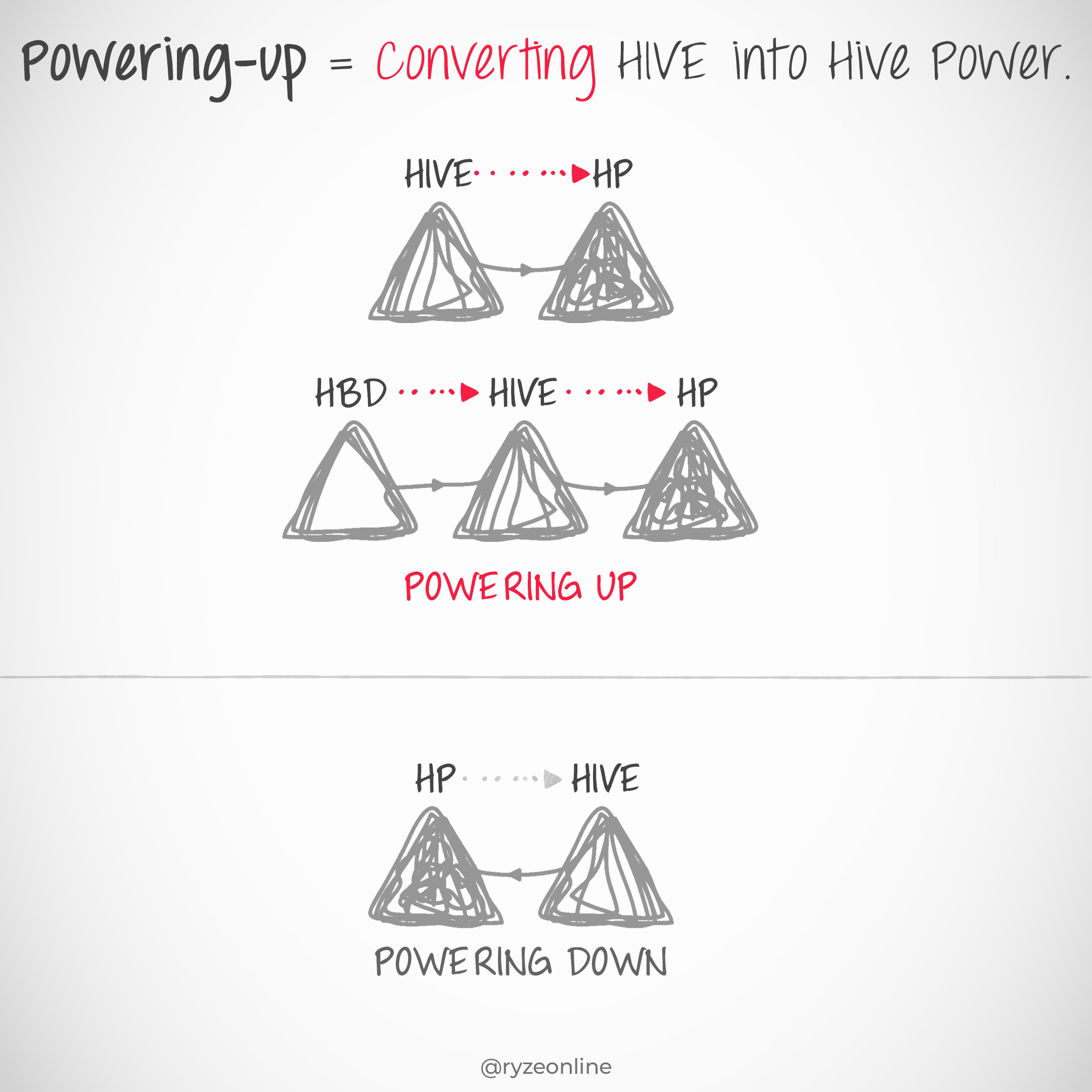 ( Note: This section received minor corrections by @antisocialist )
( Note: This section received minor corrections by @antisocialist )
“Why couldn’t they call it ‘converting?'”
“Yes, but 'conversion' is a word that means something special on the blockchain, so I avoid using it. Plus, you know how new cultures are, they always gotta have their own lingo.”
“Chevefe, parce.”
“Haha. Let’s say you go to your Hive wallet. You see you have 10 Hive tokens in it. You wish you had a bit more Hive Power to play with, you’re sitting at zero. You can click Power Up, enter an amount, say 1 Hive Tokens, and it will be converted into 1 Hive Power instead, leaving you with 9 HIVE tokens and 1 Hive Power.”
“Ah, so by converting HIVE tokens, my ‘real’ cryptocurrency, into Hive Power, I’m basically buying influence points that let’s me do stuff & earn more on the Hive.Blog social platform?”
“Exactly.”
“What about powering-down?”
“That’s just the reverse. Hive Power into HIVE tokens. Only thing is, it takes 13 weeks.”
“What?!”
“Yeah. Hive transfers one-thirteenth of your Hive Power into HIVE (tokens). It does this once a week for about 3 months. But be aware, although you’ll get a more ‘liquid’ currency in the form of HIVE tokens, powering-down does lower your influence (and earning power) on Hive.”
“How?”
“Well, imagine you’re a rich man at a bank. Do you have more influence on the bank and the bankers when your account is full and overflowing? Or do you have more influence when you pull all your money out and your account is empty?”
“When I’ve deposited millions, obviously.”
“Right, same goes for Hive. You’re storing your crypto ‘in their bank.’ As long as it’s in tied-up in Hive Power, you’re much more influential on the platform…
If you suddenly withdrew all HP, you’d be just a ‘commoner’ with minimal influence on Hive.”
“But it’s still in my account, right? I didn’t withdraw it, I just converted it from Hive Power into HIVE Tokens.”
“OK fine, but it’s still like moving money from your high-interest investment portfolio, into your low-interest checking account. It’s not a great sign, and it looks like you’re about to pull all your funds out of the bank.”
“Alright, so keep a good chunk of my funds in Hive Power if I want influence & earning power on the platform, got it.
“Fair enough. And what does this ‘influence’ (in the form of Hive Power) do exactly?”
"It affects delegation, RC, witnesses, proposals, rewards, & inflation."
“Oh, great, so Hive Power lets me do many more fancy new things I don’t understand.” “Hey, you know what RC is at least.” Harry’s shoulders dropped, but I barreled on.”
Delegation...
…is investing Hive Power in others.”
“Why would I do that?”
“To earn for yourself & believe in people. Two ways of earning HIVE Tokens is by posting, and by upvoting, like I explained earlier, right?:
“Sure.”
“But there’s a third way, delegation. You don’t have to post, you don’t have to upvote. Instead, you loan Hive Power to people you feel are active Hivers. That way you get a share of whatever they’re doing/earning on the platform.”
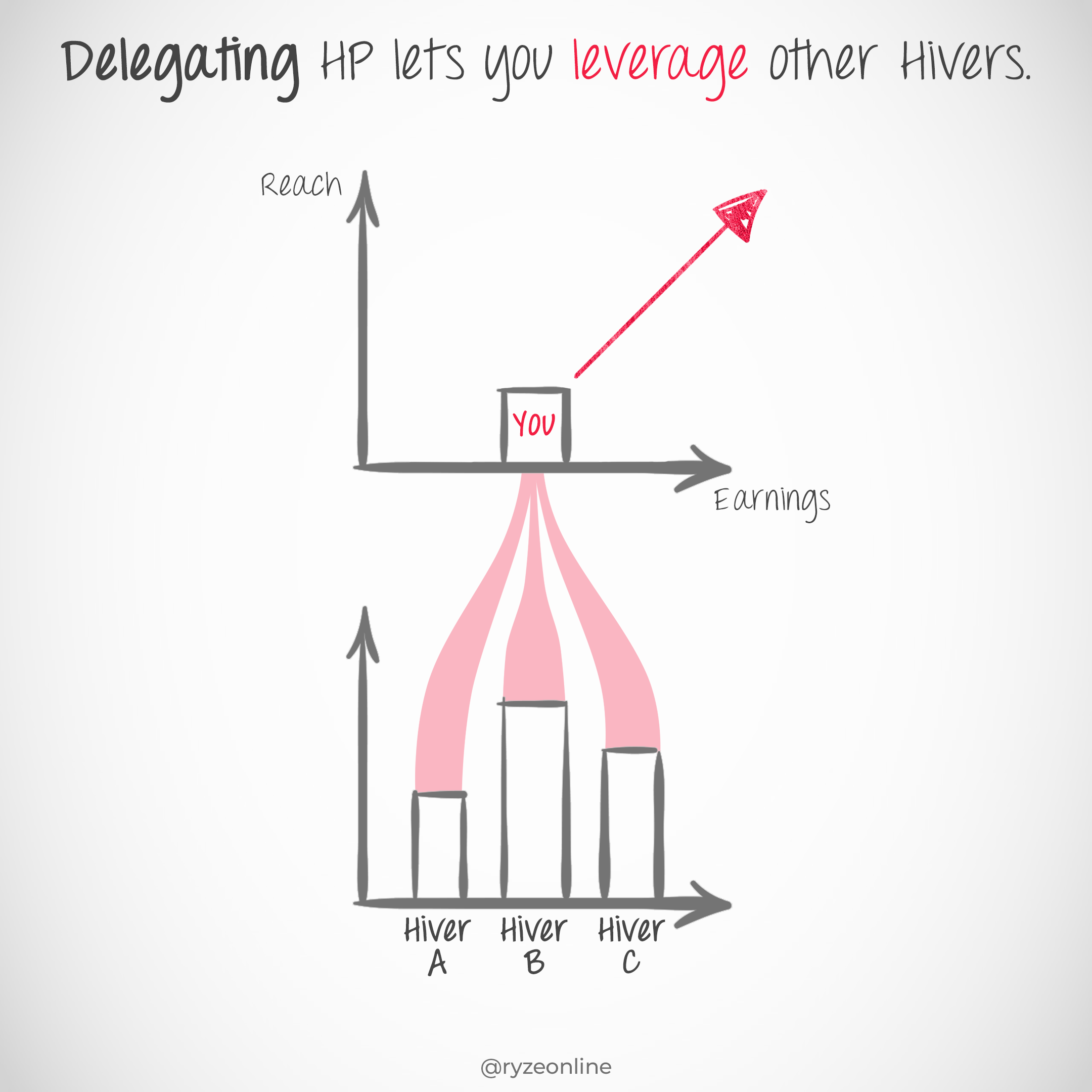
“Wow, so on most socials I don’t earn for upvoting or commenting. Those platforms don’t even pay me for posting. But on Hive, I can earn doing all those things? And even better, I can do none of that, and simply earn by delegating my Hive Power to other users?”
“You nailed it. That’s the beauty of Hive. Hive lets you earn as a creator who creates, a consumer who consumes, or even as an passive investor who ‘delegates.’ As added safety, you can un-delegate at any time too.”
"I love it. But what about proposals?"
“So Hive is by the people, for the people. This means that when you join Hive, you become a partial owner of Hive. You’re a share-holder. As Hive continues to grow, it’s users (shareholders like you) get to vote on where to invest Hive’s time, money, and resources. Do we want to control spam this month? Or do we want to focus on marketing Hive to the world? Should upvotes cost more? Or less? You’ve the option to vote on all this kind of stuff (if you want.) But some people have more influence than others.”
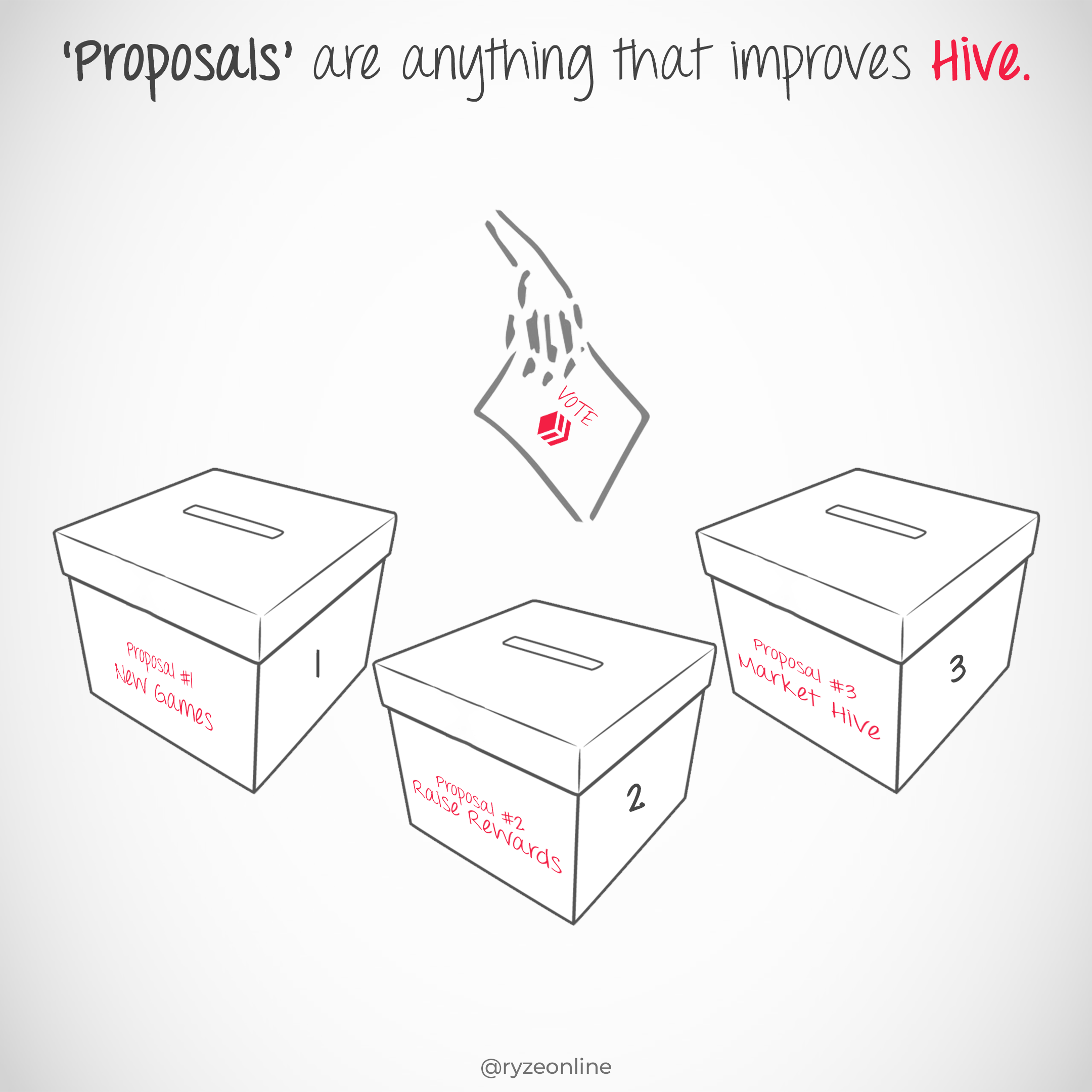
“Ah, and our Hive Power is our influence, which decides what Hive decisions get made.”
“Spot on. And these decisions are called ‘proposals’ or ‘work proposals.’ They can be anything that adds value to the Hive ecosystem (Development, Marketing, Operations, etc.) Newbies don’t usually vote on them, but you totally can, and it’s recommended. As is voting for witnesses.”
"Witnesses?"
“Yeah, they’re like ‘custodians’ of the blockchain. Hive.io takes a lot of power, bandwidth, and resources to maintain. So it needed a group of people to run the servers and take care of all the tech details. They also act kind of like senators who ‘govern’ Hive. They’re ‘voted into power’ by the users of Hive. Witnesses run the Hive Blockchain on powerful computers which make ‘blocks’ every time anyone does anything on Hive.”
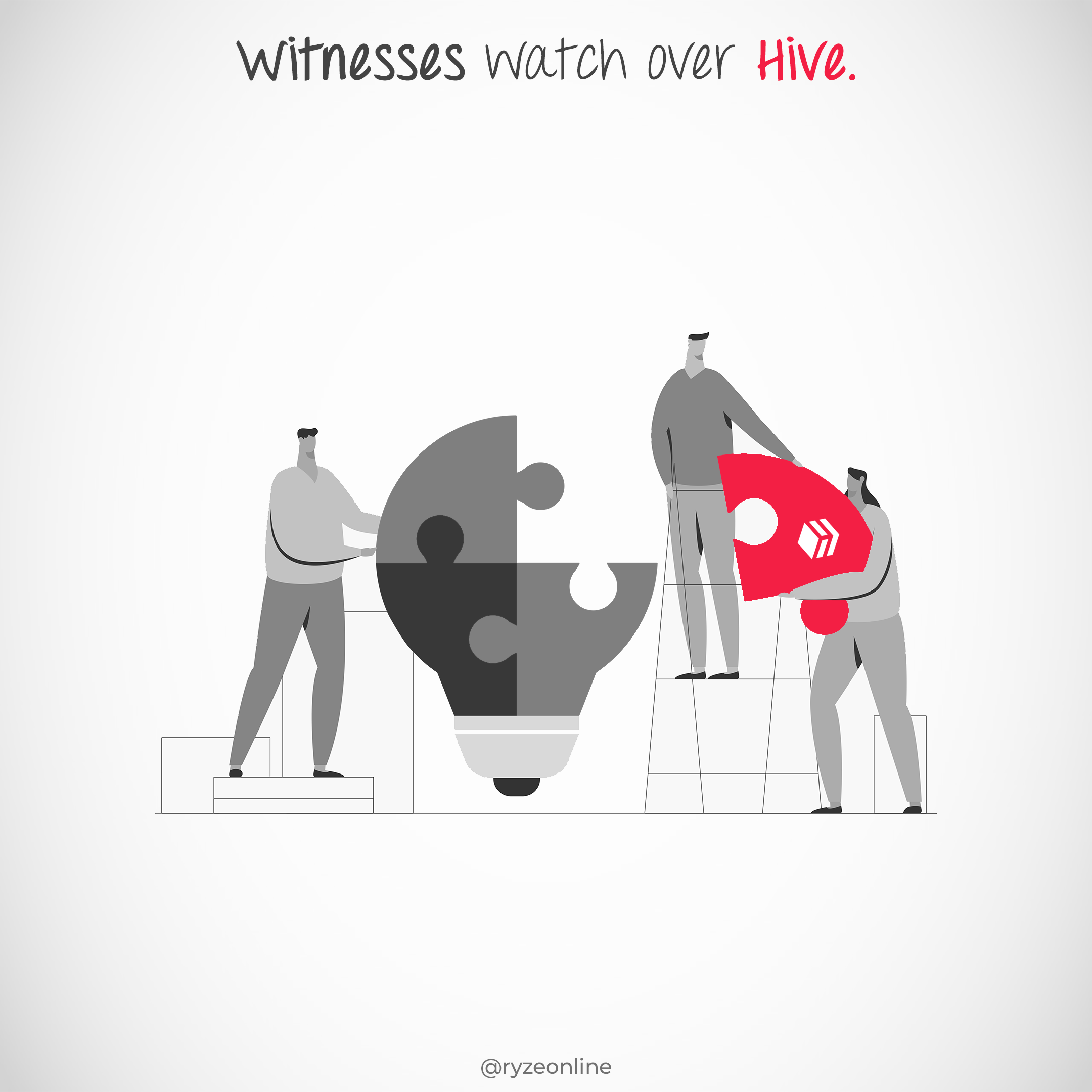
“So I could say they ‘witness’ all that takes place on Hive. Anything else?”
I rolled my eyes at Harry's pun. “Yeah, witnesses earn a lot on Hive. They receive Hive Power as rewards for producing blocks on the blockchain. Their powerful computers basically process every transaction on the Hive.io blockchain, and so, they’re rewarded for that.”
“Which means they have a lot of influence too?”
“Exactly.”
"Can I become a witness?"
Yeah, but it’s kind of like becoming the CEO of a company, it’ll take some doing. I believe @thecryptofiend made a wannabe-Witness Questionnaire 5 years ago that may still be useful for this:
https://peakd.com/@thecryptofiend/witness-questionnaire-a-solution-for-voter-confusion
"Who chooses Hive's witnesses?"
“You do.”
“Me?”
“Well, Hivians do. Any user of Hive can (and probably should) vote on witnesses. You get 30 ‘witness-votes.’ You can vote here:
https://wallet.hive.blog/~witnesses
“Maybe I’ll check it later, I wanna get back to earning on Hive.”
“Oh yeah, that reminds me, witnesses also publish HIVE prices, which helps figure out post payouts, rewards, etc.”
"Speaking of rewards...
…I’ve been pretty patient, mang. I’ve posted. I’ve upvoted. I’ve commented. I even clicked that re-blog button to help some peeps out. I don’t wanna be greedy but, can you please teach me how to get cash?”
"You get your cash from the Hive Rewards Pool."
“Say what?”
“It’s where all the cryptocurrency comes from.
Think about it. People are using Hive… so where does the money come from? Thin air? No, it comes from the Hive Rewards Pool. It’s a bunch of HIVE tokens that grows daily, adjusted for inflation. It stops growing by the year 2040. Which means Hive has a real cryptocurrency, traded on the market, that can be exchanged for other cryptocurrencies, or even withdrawn into U.S. Dollars, etc.”
“Wow. How much money is in the pool?”
“Well it changes as the Hive currency’s value changes. Last I checked, it was about half a million bucks, but who knows by now.”
“Ka-ching!”
“Sort of. Keep in mind that the amount shown next to your post is a ‘Potential Payout.’ It’s how much money your post will make.”
“What increases it?”
“Upvotes, re-blogs, etc. Great content usually gets great upvotes. Great content gets shared.”
“Shared by who?”
“Curators, mostly. But anyone, technically.”
"So 'curators' can spike the 'author' rewards?"
“Yes. And a ‘curator’ is just a fancy word for a ‘voter’, a ‘hive user’, or ‘a person doing the upvoting.’
Anyway, let’s say your post gets discovered by a curator named @johnsmithhivelover . He spends some of his resource credits to upvote your post. The more voting power he has, the more his upvote will spike your rewards. Also, your post will display a higher ‘payout amount’ in the bottom corner, and more people will recognize it as valuable. Let’s say John also re-blogs your post to his audience. Reblogging doesn’t earn directly, but now even more people will see it and likely upvote it. A lot can be earned if a few big curators (or ‘whales’) upvote and share your posts. Then you get your ‘cut’ from the Hive Rewards Pool.”
“Cool, but the people doing the upvoting get paid too, right? It’s not all for me?”
“Correct. Hive gives a percentage of the payout to the author, and a percentage of the payout to all the curators. Currently it’s 50/50 split. So when a post pays out… half of the ‘reward’ goes to the author, while the curators share the other half (based on their Hive Power / reputation score.) This is why even though there’s only one Rewards Pool in Hive, we often say there is an ‘Author Rewards Pool’ and a ‘Curator Rewards Pool’. It’s a way of looking at the giant Hive Rewards Pool as a separate content-creator (author) pool and a separate consumer (curator) pool.”
“I’m getting all of this. Thank you. But you didn’t cover inflation.”
“I’d skip it.”
“What? Why?”
"Because inflation isn't too important for beginners."
“Yeah, but now I’m getting into all this. I wanna know.”
“Ok, I honestly say beginners should skip this, but if you really want to know, check out this clip I’ve tweaked from @geekgirl:
‘Consider there’s a group of 10 people who own a company called Snoogle. Snoogle gives 100 shares to all ten of it’s owners (shareholders.) Then Snoogle decides to bring in an 11th member named Jane. Snoogle gives Jane 100 more shares for free. Seems like a bad idea, because it decreases everyone’s share of the company from